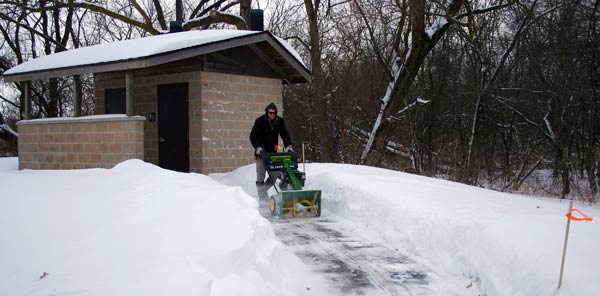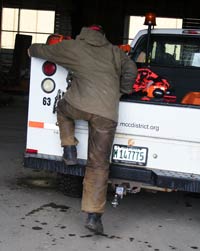
Slips, Trips and Falls Impact Winter Safety Preparations
Slips, trips and falls are a major contributor to workers’ compensation claims, and PDRMA’s PIPP and Core 6 programs encourage members to find ways to reduce or eliminate those risks.
According to Barb Bassett, Operations Coordinator, Northwest Special Recreation Association (NWSRA), “The chief areas of concern for slips, trips and falls are getting out of the accessible vehicles and when being active with participants in our programs.”
NWSRA continually trains staff on safety topics to keep participants and employees safe and has focused attention on two areas. “We increased our training for both part-time and full-time staff, and have increased our emphasis on the importance of the 30 Second Site Safety Walk Through and 3 Points of Contact,” Bassett explains. “We also added 3 Points of Contact stickers to all our vehicles.”
Supervision is key during program activities, so NWSRA staffs its groups accordingly. “We train employees on what to expect with a program, and what the plan for the day is,” she says. “It helps things run more smoothly, and that way they can anticipate what comes next if the group leader is called away.”
 Safety training is a constant process for both full-time and part-time staff. NWSRA provides in-service trainings for its full-time employees three or four times each year and reviews safety policies and topics at staff meetings. In addition, NWSRA provides every part-time employee with a variety of trainings throughout the year. The topics are based on the agency’s loss trends and PDRMA’s Loss Control Review requirements, as well as the Illinois Association of Park District’s Distinguished Accreditation Program guidelines. “We create our training outline based on those areas so all departments with part-time staff receive the same safety trainings,” Bassett adds. Safety training is a constant process for both full-time and part-time staff. NWSRA provides in-service trainings for its full-time employees three or four times each year and reviews safety policies and topics at staff meetings. In addition, NWSRA provides every part-time employee with a variety of trainings throughout the year. The topics are based on the agency’s loss trends and PDRMA’s Loss Control Review requirements, as well as the Illinois Association of Park District’s Distinguished Accreditation Program guidelines. “We create our training outline based on those areas so all departments with part-time staff receive the same safety trainings,” Bassett adds.
For example, NWSRA adopted a footwear policy for staff working in aquatic programs. Whether it’s an indoor or outdoor setting, staff — full-time, part-time and seasonal — must wear aquatic footwear for all aquatic programs.
In addition to formal orientations and trainings, NWSRA also conducts program and driver audits that focus on multiple safety points. “When incidents occur, supervisors work with employees to help them learn what could have been done differently in that situation,” Bassett explains. “We monitor trends, so we can address those risks when we notice a pattern.”
In addition to the intensive training and monitoring, NWSRA uses a variety of PDRMA resources — from stickers and videos to online training — along with the Risk Management Institute and PDRMA onsite trainings.
NWSRA’s efforts have paid off; the agency had only two slip/trip/fall incidents to date in 2015.
McHenry County Conservation District
 At McHenry County Conservation District, winter presents additional slip, trip, and fall hazards, andJenny Heider, MHRM, PHR, Human Resources Manager, says ice control is a key concern. To keep both workers and patrons safe, McHenry makes sure downspouts and gutters are secure and not distributing water over paved areas. “We also make it a point to get out to our facilities as soon as possible to clear sidewalks and parking lots.” At McHenry County Conservation District, winter presents additional slip, trip, and fall hazards, andJenny Heider, MHRM, PHR, Human Resources Manager, says ice control is a key concern. To keep both workers and patrons safe, McHenry makes sure downspouts and gutters are secure and not distributing water over paved areas. “We also make it a point to get out to our facilities as soon as possible to clear sidewalks and parking lots.”
Heider says showing PDRMA’s Core 6 video was particularly helpful in encouraging safe practices among staff. “I incorporated it into a training with the thought of encouraging employees to slow down, not be in a hurry — a particularly wise practice when out in the field,” she explains. “It’s hard to know what’s hiding in tall grass or brush; there can be uneven surfaces in fields and holes from small animals that can easily trip you up.”
Staff in the field also gets reminders about the 30 Second Site Safety Walk Through, 3 Points of Contact and the importance of wearing ice cleats, which Heider worked with PDRMA to obtain for employees.
Even housekeeping is part of McHenry’s safety effort. “A supervisor and I just completed our annual shop inspections, which include identifying housekeeping hazards such as standing water and cords or hoses on the ground.”
Whether your agency transports patrons, maintains acres of land or does a little bit of everything, maintaining a safety focus during the winter months is the best way to avoid slip, trip and fall incidents. Be sure to use the following PDRMA resources to help keep everyone focused on safety.
PDRMA Resources:
If you have questions or concerns about current signage at your facilities, ask your PDRMA Risk Management Consultant for recommendations and refer to these resources.
|

